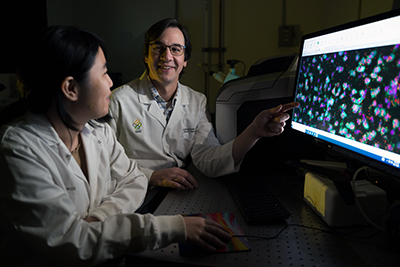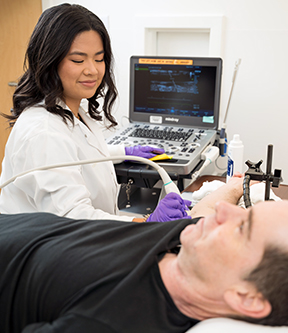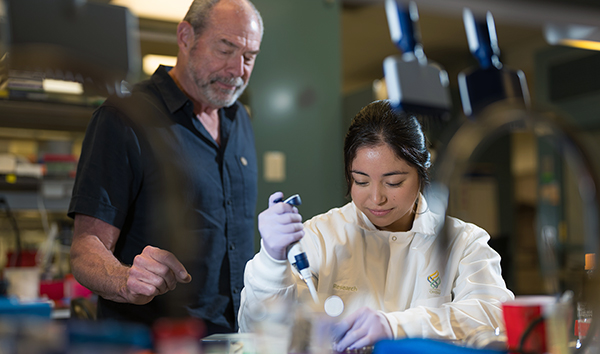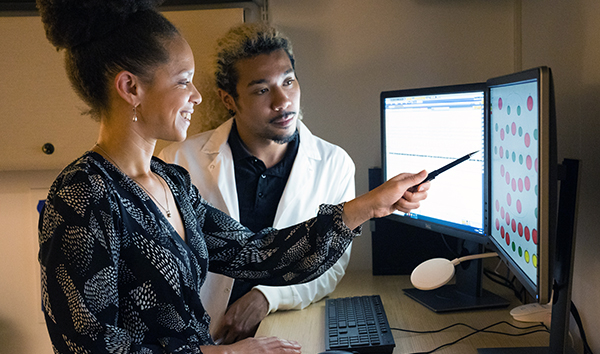Oregon Institute of Occupational Health Sciences: Institute Overview

Our Work
At the Oregon Institute of Occupational Health Sciences (Institute), we conduct research and develop evidence-based tools, training, and education to improve the safety, health and well-being of workers in Oregon and beyond.
Our research faculty are nationally recognized experts in occupational health, safety, and well-being. Their holistic, multidisciplinary approach to research encompasses areas relevant to occupational health, safety, and well-being including:
- Chemical and environmental exposure
- Sleep and circadian health
- Workplace safety
- Supportive workplace practices
Collaboration is essential to how we work. We partner with employees and employers, government agencies, unions and industry groups throughout Oregon to understand and address health-related issues impacting the workforce. We translate our research findings into evidence-based practices and work with our partners on the adoption, implementation, and evaluation of these practices.
Education is core to our mission. With partners such as Oregon OSHA, SAIF Corporation, Portland State University, and the University of Washington, we organize and deliver courses, symposia, and trainings that expand the application and knowledge of Total Worker Health® principles in Oregon and the Pacific Northwest.
The Institute is closely aligned with the National Institute of Occupational Health and Safety (NIOSH). We host two NIOSH-funded programs that deeply shape our research and practice: the Oregon Healthy Workforce Center, a NIOSH Center of Excellence in Total Worker Health (TWH) serving Oregon and the Pacific Northwest; and the Oregon Occupational Public Health Program, a partnership with Oregon Health Authority, to report on health indicators and instances of workplace exposures, injuries, and fatalities in Oregon.
The Institute is composed of about 70 people. This includes faculty, research staff, an administrative team, and an outreach and education team.
What We Do (Snapshot)
- Conduct Research –examine occupational health through the lens of basic, clinical, and applied research
- Develop and Disseminate Tools and Training – convert research into evidence-based tools and training that workplaces adopt to improve occupational health and safety
- Collaborate with Partners – collaborate with state, regional and national partners on research and adoption, implementation, and evaluation of evidence-based practices
- Deliver Educational Programming – design and deliver courses and symposia that expand the application and knowledge of Total Worker Health principals in Oregon and the Pacific Northwest

History
For more than 35 years, workers in Oregon have benefited from the state's investment in the Oregon Institute of Occupational Health Sciences. In 1985, Oregon House Bill 2290 created a center for occupational disease research and provided continuous base funding from the state’s workers’ compensation revenue. Two years later, the Oregon State Board of Higher Education provided programmatic approval for the Institute.
Funding and Multiplier Effect

The Institute receives annual base funding through Oregon’s Workers’ Benefit Fund (WBF). Institute faculty leverage this investment to secure highly competitive federal grants that bring in, on average, twice the dollar amount provided by the Oregon base funding. This allows the Institute to substantially magnify the impact on Oregon and its workforce. The total annual budget of the Institute has averaged just over $10 million for the past two decades (2002-2022). While state fundings fluctuate, the Institute’s base funding from WBF has averaged 35% of total funding over the same time. The return on investment has averaged 196%.
The Oregon Healthy Workforce Center (Center) exemplifies how Institute faculty leverage state funding to secure prestigious, national grants. Based on the strength of the Institute’s research and outreach efforts, the National Institute of Occupational Safety and Health selected the Institute as one of 10 Total Worker Health Centers of Excellence in the country in 2011. The Institute has received three successive five-year grants from NIOSH for the Center. Not only has this brought in millions of grant dollars for research, it has also positioned Oregon as a leader in TWH and created the Oregon Total Worker Health Alliance, a partnership between the Institute, Oregon OSHA, and SAIF Corporation, to expand the application and knowledge of Total Worker Health principles in Oregon. Since its formation in 2017, the Alliance has delivered training to over 1500 professionals across Oregon.

Conduct Research
Institute faculty conduct basic, clinical, and applied research, laying the foundation for advancements in worker safety and well-being. Our research is organized through four primary themes.
Environmental Exposure
Environmental extremes, including exposures to ultraviolet light (sunlight), water and air pollution, heat and smoke, and toxins, pose serious health risks to certain working populations. Scientists at the Institute characterize these risks and the mechanisms by which they adversely impact health.
Sleep and Circadian Health
Scientists at the Institute study the physiological effects of behaviors, including sleep, work schedules (such as the body’s internal circadian clock), nutrition, exercise, and tobacco and cannabinoid use, to better understand the impact each of these has on worker health, safety, and well-being.
Safety at Work
Occupational fatalities and injury are among the gravest threats to workers. To reduce this burden on worker well-being and productivity, researchers at the Institute investigate the causes and prevention of workplace injuries and fatalities, as well as workplace safety climates.
Supportive Workplace Practices
Factors including long work hours, workload, poor communication, and job insecurity all contribute to employee stress and increase the likelihood of workplace injuries and illness. At the Institute, scientists conduct workplace research that delivers supportive programming and interventions that promote worker physical and mental health.
Current Research Projects
Environmental Exposure

Workplace exposure, DNA damage, and repair mechanisms
Workplace exposure to toxins, pollutants, and environmental factors such as sunlight can damage DNA leading to the onset of disease including liver and skin cancers, metabolic diseases such as obesity and diabetes, and neurodegenerative disorders including Alzheimer’s and Parkinson’s disease. In Dr. Stephen Lloyd’s laboratory, researchers examine how enzymes within the body repair damaged DNA to combat these diseases. The lab’s discovery that OGG1 enzymes accelerate the repair of damaged DNA led Lloyd and his collaborators to develop molecules capable of stimulating OGG1 activity in cells. The lab filed a patent based on the discovery and is now working with Luciole Pharmaceuticals, a biotech company that has licensed Lloyd’s technology from Oregon Health & Science University.
Sleep and Circadian Health

Shiftwork and firefighter health
Dr. Nicole Bowles is currently working with Portland Fire & Rescue, Portland Firefighters Association, and the Eugene-Springfield Fire Department to systematically examine the association between work schedule and the mental and physical health of firefighters. Fire departments across the country are experimenting with different schedules to help firefighters recover during time-off. This study will provide evidence regarding optimum work schedules as well as interventions to improve firefighter health.
Safety at Work

Addressing emotional exhaustion among employees in primary care clinics
Stress, fatigue, and burnout among healthcare workers has been well documented since the pandemic. In recent years, many healthcare workers have left the profession, placing additional strain on those that remain and increasing the probability of accidents and injuries on the job. Recent research by Dr. David Hurtado suggests that short and frequent check-ins between healthcare workers and their supervisors may be a practical and effective tool to reduce emotional exhaustion among healthcare workers. Based on positive results from pilot research, Hurtado and colleagues are now developing and testing protocols to assess the efficacy of supervisor/employee “check-ins" to reduce emotional exhaustion and burnout in primary care settings at hospitals across Oregon.
Develop and Disseminate Tools and Training
The Institute is committed to translating research into practice. Our research faculty and staff work together closely to convert research findings into evidence-based tools and training for the workplace. We are focused on adoption and implementation of training programs in Oregon. Recent examples of how Institute research converts to practice include the Safety Health Improvement Program (SHIP), COMPASS Training for home health workers, and Mental Health Training for Managers.
Research-to-Practice: SHIP Training

The Safety and Health Improvement Program (SHIP) is an evidence-based workplace toolkit designed to help organizations promote employee health, safety, and work-life balance by increasing supervisor support and team effectiveness. The SHIP intervention study was a NIOSH-funded randomized controlled trial focusing on supervisors and their teams. It was designed to increase supervisor and peer support and decrease job strain. SHIP was tested in the construction industry with a sample of 528 employees.
SHIP has produced multiple benefits for organizations, including reductions in employee stress and work-life conflict; increases in team communication and effectiveness; improvement in employee health and safety; and enhancements to work processes and practices. SHIP training was adopted by the State of Oregon (Department of Administrative Services) and hosted on the State of Oregon’s Learning Management System. SHIP is available to state employees.
Research-to-Practice: COMPASS

The Community of Practice and Safety Support training (COMPASS) is an evidence-based toolkit designed for home care workers. Home care workers typically work in isolated settings and have an elevated risk of injuries and health problems. The COMPASS training utilizes a peer-led social support group format designed to improve social well-being, reduce the risk of injuries, and promote health among home care workers. Home care workers learn together, set goals, and get support for making changes to advance safety, health, and well-being.
COMPASS was tested on 149 homecare workers through a random controlled trial. In the fall of 2017, COMPASS was adopted by the Oregon Home Care Commission as a free training offered to home care workers. The training has been translated into Spanish, Russian, and Somali. During the pandemic, COMPASS moved to an online format and is now delivered virtually. COMPASS is promoted by the Oregon Department of Human Services “Resources for the Home Care Workforce” webpage and through their monthly newsletter.
Research-to-Practice: Workplace Mental Health Support Training for Managers

Workplace Mental Health Training for Managers is an evidence-based program developed by Dr. Leslie Hammer and colleagues that teaches leaders supportive strategies that protect and promote positive mental health. It also helps managers recognize and respond to signs that an employee may be experiencing distress. The training consists of a one-hour computer-based course that has been tested in U.S. workplaces. The training is currently being piloted with several institutions of higher education throughout the United States, including Oregon Health & Science University, Harvard University, and Northwestern University.

Collaborate with Partners
The Institute collaborates with state, regional, and national partners on research and the adoption and implementation of evidence-based practices.
Oregon Healthy Workforce Center: A NIOSH Center for Excellence for Total Worker Health
Founded in 2011, the Oregon Healthy Workforce Center (OHWC) is a Total Worker Health® Center of Excellence funded by the National Institute for Occupational Safety and Health (NIOSH). OHWC is the only Total Worker Health (TWH) Center of Excellence in NIOSH Region 10, which includes Oregon, Washington, Idaho, and Alaska. OHWC conducts research, outreach, and education to improve worker well-being using the TWH approach.
Mission and Theme
OHWC’s mission is to improve worker well-being by helping organizations prioritize physical and psychosocial safety in the workplace, design safe and healthy work, and develop positive work experiences. The Center’s theme in the 2021-2026 funding cycle is TWH intervention effectiveness, translation, and outreach to advance safe and healthy work design.
OHWC pursues the following interrelated goals:
- Conduct research on TWH-based organizational approaches for worker safety, health, and well-being.
- Create and disseminate educational and evidence-based resources that organizations can implement to foster TWH in the workplace
- Provide educational opportunities for practitioners to learn about and apply TWH in the workplace.
- Develop stakeholder partnerships and collaborative opportunities for moving TWH-based practices into action.
What is Total Worker Health?
Total Worker Health supports the growth of effective health and safety programs by proposing an integrated strategy to address both mental and physical health at work. This idea is supported by extensive research on how various working conditions influence health, well-being, and productivity, and on the recognition that work is a social determinant of health. Beyond traditional worker exposure to various workplace hazards, research shows the influence of psychosocial and organizational hazards such as job demands and pressures, degree of autonomy and flexibility, quality of interactions with supervisors and coworkers, frequency of shiftwork, and length of the workday. This broad-scale prevention approach prioritizes a hazard-free work environment for all workers with intentional and meaningful collaborations that can result in healthier workplaces.
Oregon Occupational Public Health Program: A NIOSH State Occupational Safety and Health Surveillance Program
The Oregon Occupational Public Health Program (OPHP), established in 1992 and supported by the National Institute for Occupational Health and Safety (NIOSH), develops robust surveillance systems and effective partnerships with stakeholders in occupational health to promote health and safety in the workplace. This is achieved through reporting on occupational health indicators and instances of workplace exposures, injuries, and fatalities. These two components—workplace health indicators and surveillance—form the core of the program.
OPHP is a partnership between the Oregon Institute of Occupational Health Sciences and the Oregon Health Authority. It is one of 22 state surveillance programs sponsored by NIOSH.
Occupational Health Indicators
An occupational health indicator is a specific measure of a work-related disease or injury, or a factor associated with occupational health, such as workplace exposures, hazards, or interventions, in a specified population. Indicators are often generated by the state to track trends in the workplace's occupational health. Examples of occupational health indicators include counting the number of work-related deaths and work-related poisonings.

Oregon Fatality Assessment Control and Evaluation Project
The Oregon Fatality Assessment and Control Evaluation (OR-FACE) program conducts investigations of fatal occupational incidents to assess risk factors that include the working environment, the worker, activity, tools, energy exchange, and the role of management. The program produces Investigation Reports, Incident Maps, Incident Abstracts, Toolbox Talks and Hazard Alerts.

Deliver Educational Programming
We deliver courses, symposia, and training that seek to expand the application and knowledge of Total Worker Health principles in Oregon and the Pacific Northwest.
Oregon Total Worker Health Alliance Curriculum
A statewide partnership between the Institute, Oregon OSHA and SAIF Corporation to expand the application of TWH principles in Oregon. The Alliance Curriculum is composed of entry-level courses and workshops offered free of charge either online or in-person.
Total Worker Health Professional Certificate
A professional certificate designed to equip working professionals with a deep and practical understanding of the TWH approach. The certificate program is hosted by the University of Washington, Northwest Center for Health and Safety in close collaboration with the Institute.
Fall and Spring Symposia
Institute symposia bring together scientists, practitioners, policymakers, employers, and workers to explore the latest developments in occupational health science and workplace solutions. Continuing education or professional development credits are available for attendees.
Summer Institute
A biannual multi-day conference where national and international experts in occupational health and safety present research on issues facing workplaces today. Delivered in partnership with Portland State University’s occupational health psychology graduate program.